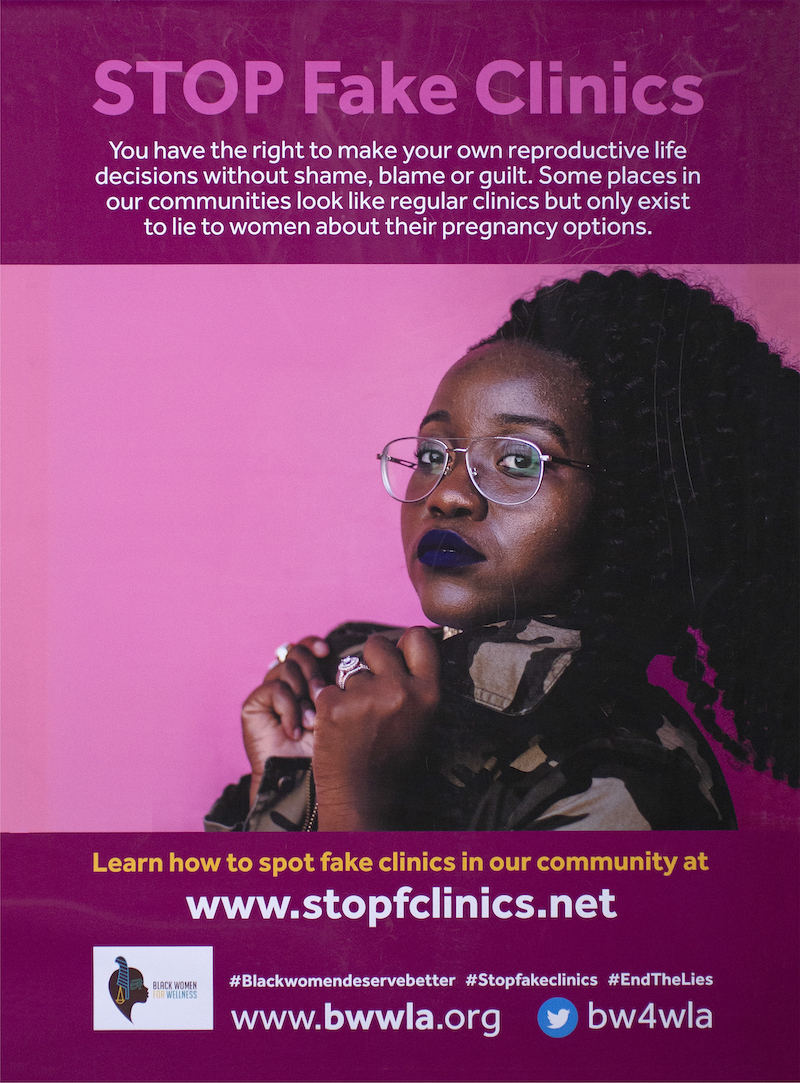Social Justice Posters Highlight Health Care in a Magnificent Collaboration
An exhibition at Mercado La Paloma in South Central Los Angeles reminds viewers of the power of art to fuel change. Cropped view of the "Stop Fake Clinics" digital print, produced in 2018 by Black Women for Wellness in Los Angeles, and included in the Health Care Not Wealth Care: Posters on Health Activism and Social Justice" exhibition from the Center for the Study of Political Graphics (CSPG). (Image courtesy of Carol Wells/CSPG)
Cropped view of the "Stop Fake Clinics" digital print, produced in 2018 by Black Women for Wellness in Los Angeles, and included in the Health Care Not Wealth Care: Posters on Health Activism and Social Justice" exhibition from the Center for the Study of Political Graphics (CSPG). (Image courtesy of Carol Wells/CSPG)
The Center for the Study of Political Graphics and the Esperanza Community Housing Corporation have combined forces to bring 75 powerful and engaging poster works on broad issues of health care to audiences traditionally excluded from the art world in Los Angeles and elsewhere. In more than four decades of chronicling visual artworks that address compelling issues of social justice, I have never seen such a perfect collaboration of two venerable institutions devoted to the finest ideals of humankind. Both organizations have been in the forefront of social change for three decades. Their missions are different, but they overlap in ways that encourage vigorous artistic expression with socially conscious content.
The Center for the Study of Political Graphics, the originator of the stunning bilingual show—on display at Mercado La Paloma in South Central Los Angeles through Sunday—has been collecting, preserving and exhibiting political posters on numerous themes throughout the country and internationally for many years. Its focus has been on posters from historical and contemporary movements for social change. Its exhibitions promote the power of art to educate and inspire people to social action.
Esperanza Community Housing Corporation is a remarkable institution that serves indigenous, black and Latino immigrant communities that historically have been deeply oppressed by health disparities, gentrification, displacement and disinvestment. The organization develops affordable housing, promotes health equity and access to care, mobilizes for environmental justice, and encourages and facilitates economic opportunities in South Central Los Angeles. Above all, it seeks to build hope with populations that have too often lacked it in a racist society.
The organization is located in a large building that was previously a sweatshop, where exploited women bent over sewing machines to produce garments and other products for predatory manufacturers. Esperanza Community Housing is now located in Mercado La Paloma, a market that provides business opportunities for neighborhood residents to reconstruct the bustling markets left behind in their home countries.
Notably, the market has eateries that counter unhealthy and predatory fast-food establishments like McDonalds, Carl’s Jr., KFC and scores of others that pervade urban life, but especially in inner cities with large communities of color. Mercado La Paloma features Mexican, Thai, Ethiopian and other restaurants that serve people’s needs rather than corporate greed. Five hundred customers a day come to the market, seven days a week. All have the opportunity to see the art displayed in the ordinary course of their daily lives.
Arts and culture are a core component of Esperanza’s institutional social justice mandate. The organization empowers local artists, sponsors festivals and offers art exhibitions throughout the year, including the current one, titled “Health Care Not Wealth Care: Posters on Health Activism and Social Justice.” It encompasses yet far transcends the rallying cry of health care for all, as important as that goal is in a nation where millions of residents lack even the rudiments of medical, dental and psychological coverage. To date, it has supported more than 300 local artists with exhibit and performance space. Much of this creative activity celebrates the diverse cultures of South Los Angeles. Above all, the arts focus reflects the deeper commitment to the older, magnificent bread and roses vision that emerged from the historic 1912 textile strike in Lawrence, Mass., when courageous women and men fought for something more than mere subsistence living: “Yes, it is bread we fight for, but we fight for roses too.”

The partnership of both organizations enables market visitors to enjoy and contemplate the political messages of the posters as they sit at tables eating their meals. The exhibition begins with a quotation from Martin Luther King Jr., in English and Spanish, that sets the tone for all that follow: “Of all the forms of inequality, injustice in health care is the most shocking and inhumane.”
The exhibition includes posters from such renowned artists as Robbie Conal, Doug Minkler, Mariona Barkus, Seth Tobocman, the Guerrilla Girls and Klaus Staeck. Its thematic range and comprehensive coverage make it unique among exhibitions focusing on medical and health care issues.
One of the most powerful posters on display is a 2016 work titled “Exide,” which has unnerving relevance to the South Central Los Angeles neighborhood. In 2000, Exide Technologies operated a battery plant around the clock, seven days a week, in nearby Vernon. In 2013, residents of the predominantly Latino communities near the facility learned that the company had been spewing lead and arsenic emissions into their neighborhoods for many years. These substances caused learning disabilities and cancer among the low-income residents. The poster was part of the community’s efforts to raise awareness about environmental racism in the Los Angeles area and elsewhere.
The University of Southern California’s Community Outreach and Engagement Program created the poster, encouraging people to organize against the environmental catastrophe. In 2015, Exide signed an agreement with the U.S. attorney’s office to close its plant permanently in order to avoid prosecution for its environmental criminal conduct. This is one of hundreds of examples of how art can foster political awareness.
The exhibition also highlights an equally powerful 2016 poster about another environmental and political calamity. Rudolph Pokorny’s “Citizens of Flint: Eat Lead” exposed one of the most grotesque policies in recent decades. Seeking to “save money,” the local government switched the city water source in Flint, Mich., to the Flint River. Flint’s mostly black residents almost immediately began to see, taste and smell the difference in their water, but for two years, their complaints were ignored. They were forced to drink and bathe in contaminated water.
State officials knew that the water supply had been contaminated and deliberately concealed this knowledge. Many lawsuits have been filed, but the health damages have been done. The dramatic “Citizens of Flint: Eat Lead,” with its image of a pistol pointed at the residents of Flint, and many other artworks, has informed people throughout the nation of the deeply racist nature of this tragedy.
Some of the posters focus on a theme often neglected in contemporary debates about health care: gun violence. Especially in South Central Los Angeles and similar low-income communities, where shootings are an unfortunate daily occurrence, this problem needs to be recognized as a public health crisis. As Mariona Barkus reveals in her 2018 poster, the American Academy of Pediatrics called gun violence the third leading cause of death for children. Her poster and others in the show remind viewers that this problem needs to be solved.
Domestic violence is another profound feature of health care that needs to be addressed. Three heartbreaking posters, one in Spanish, drive the point home. The artworks reveal the devastating effects of domestic violence on women, and especially on mothers and their children. This scourge, to be sure, affects the populations that regularly visit Mercado La Paloma, but it also cuts across racial and class lines throughout the nation. These posters are vivid visual reminders of a crisis enveloped in the fog of taboo and denial.
The exhibition also features posters from several countries and time periods that reveal the global struggle for decent treatment and appropriate accommodations for people with disabilities. One dramatic example is from German artist Klaus Staeck, who depicted the Mona Lisa in a wheelchair. This image is jarring for audiences who know Leonardo da Vinci’s portrayal of her enigmatic smile and then realize that even she can be subject to a life-altering impairment. Other posters in this category are similarly unnerving and encourage viewers to reflect on the continuing inadequacy of resources for disabled people.
AIDS and sexually transmitted diseases remain enormous health care issues in the U.S. and the world, despite significant medical advances in recent years. The exhibition features the iconic “Silence = Death” poster produced by The Silence = Death Collective and ACT UP. The work appropriated the pink triangle the Nazis used to persecute homosexuals during the Holocaust. Used as a consciousness-raising artistic symbol in the 1980s, it retains its force in the continuing battle against AIDS in Africa, Asia and elsewhere—as well as in parts of the U.S., especially among incarcerated people. Other posters warn of the dangers of inadequate treatment for people with STDs.
The battle for reproductive rights has become a huge public policy issue in the wake of recent attempts to defund Planned Parenthood, and in Missouri, Louisiana, Alabama and other states, to eliminate abortion altogether. Several posters, including some recent efforts, warn viewers of the dangerous attacks on the right to choose.
An especially significant work picturing a young black woman in this category came from Black Women for Wellness. This poster warns women to be alert for fake clinics, especially in African American communities. Anti-choice extremists have established almost 4,000 bogus “health” clinics throughout the country, which do not provide reproductive health services; instead, women are lied to and pressured about their decision to obtain abortions. Some are even told that abortions cause cancer. Some of these institutions that prey upon vulnerable populations have even received public funding.
Few Americans are aware of another health crisis: female genital mutilation (FGM), which has profoundly disturbing implications for more than 300 million girls and women, especially in Africa, the Mideast and Asia. An older poster addresses the practice of removing parts of female genitals, depicting it as a feature of male control over female sexuality. FGM can have severe health consequences, including difficulties passing urine and menstrual flow, chronic pain and even fatal bleeding. The text of the poster contains outdated information, reminding audiences that FGM is far from dead; although illegal in the U.S., in 2017 CNN reported that it is on the rise, especially among immigrant groups in California, New York and Minnesota.
Most people who regularly patronize Mercado La Paloma are familiar with workplace hazards. Several posters in the exhibition address the pervasive problems of occupational health and safety. Asbestosis, lead poisoning, burns, amputations, emphysema, dermatitis, skin cancer and deafness have plagued the workplace for decades, despite laws and regulations ostensibly designed to curb abuses.
People in clerical positions, mostly women, are subject to an often-ignored workplace hazard. Doug Minkler’s poster, “More Than a Paycheck,” show how people behind computers bring home eyestrain, backaches, headaches and stress after long hours of repetitive work. Too often, office supervisors view these pink-collar workers as little more than extensions of their computers. This is an international health crisis of the highest magnitude.
Uniting all the diverse themes of these vibrant poster artworks is the demand for health care for everyone. The exhibition recognizes, explicitly and implicitly, the issue of health as a human right and its American corollary—“Medicare for All.” Patrons of Mercado La Paloma and casual viewers of “Health Care Not Wealth Care: Posters on Health Activism and Social Justice” are encouraged to reflect on the present inadequacies of our medical system and to mobilize politically to change it.
In addition to inadequate health care, progressives must recognize and address the fundamental underlying problems of American corporate capitalism: the prison-industrial complex, police misconduct, unnecessary war and out-of-control militarism, seemingly intractable racism, sexism and homophobia, profound disparities of wealth and power and inadequate educational opportunities.
Art, throughout history, has played a major role in generating consciousness of grave social, political and economic ills. Both the Esperanza Community Housing Corporation and the Center for the Study of Political Graphics, through their past, present and future exhibitions, play an indispensable part in this process.
Your support matters…Independent journalism is under threat and overshadowed by heavily funded mainstream media.
You can help level the playing field. Become a member.
Your tax-deductible contribution keeps us digging beneath the headlines to give you thought-provoking, investigative reporting and analysis that unearths what's really happening- without compromise.
Give today to support our courageous, independent journalists.






You need to be a supporter to comment.
There are currently no responses to this article.
Be the first to respond.